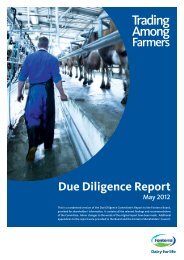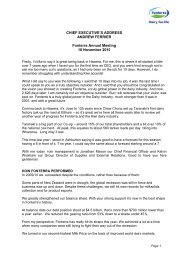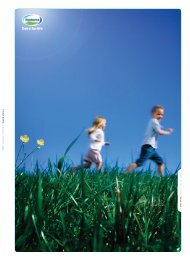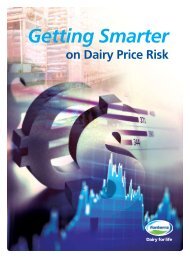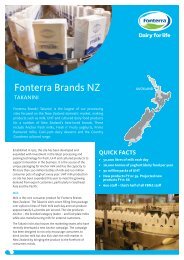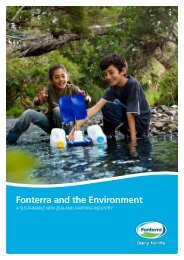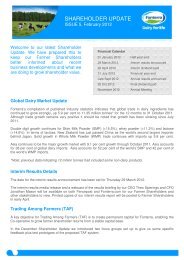A Fonterra Guide to Climate Change
A Fonterra Guide to Climate Change
A Fonterra Guide to Climate Change
- No tags were found...
Create successful ePaper yourself
Turn your PDF publications into a flip-book with our unique Google optimized e-Paper software.
What fac<strong>to</strong>rs cause animal emissions <strong>to</strong> fluctuate?Research from the Pas<strong>to</strong>ral Greenhouse Gas Research Consortium indicates that there is a correlation between thegenetics of the animal and the emissions it releases. Research in<strong>to</strong> this link is ongoing.Another fac<strong>to</strong>r is feed consumption: the more food consumed, the higher the emissions. If highly productive animalscan be identified, this will result in more milk being produced from fewer cows. This will lower the amount ofmaintenance feed required and, ultimately, reduce emissions from the herd.What is the status of research in<strong>to</strong> the use of nitrification inhibi<strong>to</strong>rs?Nitrification inhibi<strong>to</strong>rs can increase productivity while lowering nitrous oxide emissions. Trials have shown 30-70 percent reductions in nitrous oxide production through the use of inhibi<strong>to</strong>rs and they also have been shown <strong>to</strong> improvepasture productivity by between 15-20 per cent under the best conditions. However there are some questionsremaining around their effectiveness in different soil types and conditions.<strong>Fonterra</strong> is working with the Ministry of Agriculture and Forestry, DairyNZ, the Pas<strong>to</strong>ral Greenhouse Gas ResearchConsortium and the fertiliser industry <strong>to</strong> undertake further research which will provide further clarification of theregional variation in results.Nitrification inhibi<strong>to</strong>rs must gain formal international recognition before they can be counted as a <strong>to</strong>ol for reducingNew Zealand’s agricultural emissions. The process of gaining international recognition is currently underway, and ifsuccessful nitrification inhibi<strong>to</strong>rs will be the first approved mitigation technique for agricultural emissions.<strong>Fonterra</strong> has said that improving animal productivity can reduce methaneemissions for a set volume of milk. How does this work?Research has suggested that improving productivity will result in fewer emissions for a set volume of milk production(also referred <strong>to</strong> as lower emissions intensity).Methane emissions arise from the feed consumed by the animal for normal body maintenance, growth or milk production.So the more feed consumed the greater the quantity of methane emitted. Producing the same volume of milk with feweranimals means that less feed is needed for body maintenance, but the same amount of feed is needed for milk production.Therefore less feed in <strong>to</strong>tal is required <strong>to</strong> produce the same volume of milk, resulting in lower methane emissions.Increase productivity per animalDDMI Milk yield (kg/d) CH 4 (kg/d) % CH 4 associated with CH 4 /milk (g/kg)MaintenanceProduction7.9 12 206 51 49 17.210.5 20 272 39 61 13.611.7 24 305 34 66 12.7Source: O’Hare et al. (2003)If the dairy system is carbon in (pasture) and carbon out (milk), shouldn’tit be carbon neutral?Carbon is absorbed in<strong>to</strong> the pasture from atmospheric carbon dioxide with approximately 75 per cent released backin<strong>to</strong> the atmosphere from plant respiration and decomposition. The remaining carbon in plant material is consumed bythe animal and provides the energy needed for its maintenance and milk production. The carbon in faeces, urine andmilk products is also eventually released back <strong>to</strong> the atmosphere as carbon dioxide. However, a small portion of thecarbon in pasture is released not as carbon dioxide (CO2), but as methane (CH4) which arises when feed is digested.Under the Kyo<strong>to</strong> pro<strong>to</strong>col methane is considered <strong>to</strong> have 21 times the heat trapping ability of carbon dioxide over a100 year period. Therefore the carbon balance of the dairy farm system may be neutral but the problem is that thedairy cow changes a small proportion of carbon in<strong>to</strong> something that has a greater impact on the atmosphere – leavingthe <strong>to</strong>tal dairy system in the red.There is some debate regarding the current treatment of methane under the Kyo<strong>to</strong> Pro<strong>to</strong>col, including the differentatmospheric lifetimes of different gases and the comparability of warming at different times in the future fromdifferent gases. <strong>Fonterra</strong> is encouraging the New Zealand Government <strong>to</strong> ensure the science is clarified andappropriately reflected in any future international rules.14





